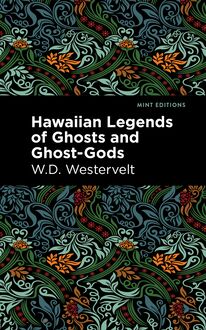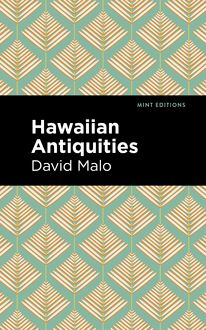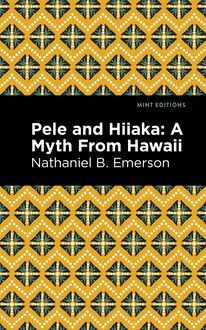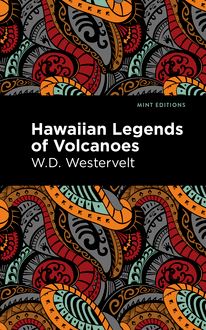-
 Univers
Univers
-
 Ebooks
Ebooks
-
 Livres audio
Livres audio
-
 Presse
Presse
-
 Podcasts
Podcasts
-
 BD
BD
-
 Documents
Documents
-
- Cours
- Révisions
- Ressources pédagogiques
- Sciences de l’éducation
- Manuels scolaires
- Langues
- Travaux de classe
- Annales de BEP
- Etudes supérieures
- Maternelle et primaire
- Fiches de lecture
- Orientation scolaire
- Méthodologie
- Corrigés de devoir
- Annales d’examens et concours
- Annales du bac
- Annales du brevet
- Rapports de stage
La lecture à portée de main
Vous pourrez modifier la taille du texte de cet ouvrage
Découvre YouScribe en t'inscrivant gratuitement
Je m'inscrisDécouvre YouScribe en t'inscrivant gratuitement
Je m'inscrisEn savoir plus
Vous pourrez modifier la taille du texte de cet ouvrage
En savoir plus

Description
Hawaiian Legends of Volcanoes (1916) explores Hawaiian folktales and myths collected by W. D. Westervelt. Connecting the origin story of Hawaii to the traditions of other Polynesian cultures, Westervelt provides an invaluable resource for understanding the historical and geographical scope of Hawaiian culture.
Beginning with the origin story of Pele, the goddess of volcanoes, Westervelt introduces his groundbreaking collection of legends on the volcanic nature of the Hawaiian Islands. When the goddess Pele comes to the island of Hawaii seeking a permanent home, she finds Ai-laau, another god of fire, already in possession of the territory.
Despite his fearsome power over creation and destruction, Ai-laau disappeared the moment he became aware of Pele’s presence. Having traveled across the limitless ocean, her name was already known far and wide, along with her reputation for strength, anger, and envy. Establishing herself within the crater of Kilauea, Pele quickly took command over the gods, ghost-gods, and the people inhabiting the islands. Central to Hawaiian history and religion, Pele continues to be celebrated in Hawaii and across the Pacific today.
With a professionally designed cover and manuscript, this edition of W. D. Westervelt’s Hawaiian Legends of Volcanoes is a classic of Hawaiian literature reimagined for modern readers. Add this beautiful edition to your bookshelf, or enjoy the digital edition on any e-book device.
Sujets
Informations
| Publié par | Mint Editions |
| Date de parution | 08 juin 2021 |
| Nombre de lectures | 2 |
| EAN13 | 9781513223834 |
| Langue | English |
| Poids de l'ouvrage | 2 Mo |
Informations légales : prix de location à la page 0,0400€. Cette information est donnée uniquement à titre indicatif conformément à la législation en vigueur.
Extrait
Hawaiian Legends of Volcanoes
W.D. Westervelt
Hawaiian Legends of Volcanoes was first published in 1916.
This edition published by Mint Editions 2021.
ISBN 9781513299570 | E-ISBN 9781513223834
Published by Mint Editions®
minteditionbooks.com
Publishing Director: Jennifer Newens
Design & Production: Rachel Lopez Metzger
Project Manager: Micaela Clark
Typesetting: Westchester Publishing Services
T ABLE OF C ONTENTS I NTRODUCTION : T HE H AWAIIAN I SLANDS P ART I. L EGENDS I. A I -L AAU , THE F OREST E ATER II. H OW P ELE C AME TO H AWAII III. P ELE AND THE O WL G HOST -G OD IV. T HE H ILLS OF P ELE V. P ELE AND THE C HIEFS OF P UNA VI. P ELE ’ S T REE VII. P ELE AND K AHA -W ALI VIII. P ELE AND K AMA -P UAA IX. P ELE AND THE S NOW -G ODDESS X. G ENEALOGY OF THE P ELE F AMILY XI. P ELE ’ S L ONG S LEEP XII. H OPOE , THE D ANCING S TONE XIII. H IIAKA ’ S B ATTLE WITH D EMONS XIV. H OW H IIAKA F OUND W AHINE -O MAO XV. H IIAKA C ATCHING A G HOST XVI. H IIAKA AND THE S EACOAST K UPUAS XVII. L OHIAU XVIII. T HE A NNIHILATION OF K EOUA ’ S A RMY XIX. D ESTRUCTION OF K AMEHAMEHA ’ S F ISH -P ONDS XX. K APIOLANI AND P ELE P ART II. G EOLOGICAL F ACTS I. T HE C RACK IN THE F LOOR OF THE P ACIFIC II. H AWAIIAN V OLCANOES III. V OLCANIC A CTIVITY IV. C HANGES IN K ILAUEA C RATER V. F OUNDATION OF THE O BSERVATORY A PPENDIX : P OLYNESIAN L ANGUAGE
I NTRODUCTION
The Hawaiian Islands
Of all the noteworthy groups of islands of fire rock in the Pacific Ocean, the Hawaiian Islands are the most stupendous.
The crack in the floor of the ocean upon which they are built extends from the large island Hawaii northwesterly about two thousand miles toward Japan. The islands for the first four hundred miles are large and mountainous, but as the chain is followed toward the end; the islands quickly become mere bluffs rising out of the sea, or low coral islands which have been built on the rims of submerged volcanoes.
It is interesting to note that the oldest, the smallest, and the lowest of these islands lie nearest to Japan. One of these—Midway Island—is used as the United States mid-Pacific cable station. Properly speaking, the Hawaiian Island group should cover all the islands in this chain two thousand miles long. The mountains of the large islands rise from 3,000 to 14,000 feet above the sea-level. Between this majestic range of island mountains and the “Giants of the Rockies,” along the western coast of the United States, lies a rough ocean valley abounding in hills and deep ravines with an average depth under the sea-surface of about 2,600 fathoms, or 15,600 feet.
We know very little about this valley save that its floor is covered with evidences of volcanic action. Pumice and scori æ appear to be universally distributed on the bottom of the ocean. Red and gray, and blue and green clays abound. The disintegration of pumice is given as the chief source for the formation of this clayey matter. Sometimes the deposits are permeated with meteoric or star dust.
As the ocean depths draw near the island coasts, they grow more and more shallow and become a wonderful fairy-land into which the dreamer looks from his floating canoe. Strange branching thickets of coral lie below, sometimes fringed with moving seaweeds and exquisitely colored sea-mosses, while through the coral and moss swim the marvellously painted fish of a hundred varieties. Turning and twisting in and out of coral caves are the spotted eels or the great pink or brown anemone-headed sea-worms. Sea-urchins and star-fish crawl lazily along the valleys and the uplands of the coral reef. The surface of the sea is itself covered with ceaselessly moving waves reflecting a tropical luxuriance Of color. From well-known localities hundreds of fishermen gather spoil for the sustenance of life for themselves and their friends.
Wonderfully restful is the dream life of the winterless seas of the coral caves, and yet even today fierce floods of boiling lava sometimes find their way over the seashore and down over the reefs, destroying the life of sea-moss and coral polyps, and surrounding shells and fish and crawling slugs or swift-moving eels with floods of turbid, boiling, death-dealing water in place of the clear waves through which they had been accustomed to journey.
Each island has its individual extinct craters, but no island has any form of hot geyser action such as characterizes the Yellowstone Park of the United States, or the region around Rotorua, New Zealand. The nearest approach to a geyser deposit such as abounds in central Mexico is found on Molokai and around the small crater Leahi (Diamond Head), near Honolulu. Leahi was evidently forced up through coral reefs and the mighty heat produced small layers of geyser-like deposits.
The islands have been built up by lava alone. This lava rapidly falls to pieces under the influence of sunlight and rain, thus permitting plants, such as giant ferns, small shrubs and grasses, to take root. These plants break up the fire-rock very rapidly and send seeds broadcast to multiply soil-making activities. Thus a lava flow in a few years becomes the foundation for a growing forest.
The fire-rock, breaking through the floor of the ocean to form the Hawaiian chain of islands, lost its power first in the far northwest and cooled and hardened from island to island until it is now making its last appearance on the largest and most southeasterly of all the group, the island known by the name Hawaii. Here is still to be found what is called the largest active crater in the world, Kilauea, and the sister crater, Mokuaweoweo, from which come the most voluminous lava flows, the latest one being in May, 1916. Kilauea is about 4,000 feet altitude, while Mokuaweoweo is nearly 10,000 feet higher and is on the summit of Mauna Loa. Professor Jaggar, the experienced volcanologist in charge of an observing station on the brink of Kilauea, accepts the theory of a gas connection between these two craters so that their activity is mutual as to foam vents, but not so close that the lower volcano affords a hydrostatic outlet to the lava in the higher crater.
In this place it is well to note a fact which makes the scientific study of the active fire-lake of living volcanoes a very valuable index of coming events. Professor Jaggar says: “It has long been known that the crust of our rocky globe rises and falls with a tide similar to that of the ocean. From direct experiment professors of Chicago University have recently proved a tidal movement in the solid earth up and down of about a foot twice each day, and varying in amount through the lunar month and the solar year. There is definitely a daily movement marked in the lava level of the fire-pit of Kilauea, and there is a marked semi-annual high level.” This scientific study of active craters is still in its infancy and promises, as Professor Jaggar says, “to create a new science in which we may hope at some not distant day to predict the periods of volcanic eruptions and earthquakes.”
The early Hawaiians incorporated in their legends various theories to explain these great phenomena of nature, many of which are included in this volume, especially those legends which cluster around Pele, the great goddess of fire, and Hiiaka, her sister, goddess of lightning. Other interesting legends relating to the once active but long extinct crater Haleakala, on Maui, may be found in “Legends of Maui.”
PART I
LEGENDS
I
A I L AAU , THE F OREST E ATER
When Pele came to the island Hawaii, seeking a permanent home, she found another god of fire already in possession of the territory. Ai-laau was known and feared by all the people. Ai means the “one who eats or devours.” Laau means “tree” or a “forest.” Ai-laau was, therefore, the fire-god devouring forests. Time and again he laid the districts of South Hawaii desolate by the lava he poured out from his fire-pits.
He was the god of the insatiable appetite, the continual eater of trees, whose path through forests was covered with black smoke fragrant with burning wood, and sometimes burdened with the smell of human flesh charred into cinders in the lava flow.
Ai-laau seemed to be destructive and was so named by the people, but his fires were a part of the forces of creation. He built up the islands for future life. The process of creation demanded volcanic activity. The flowing lava made land. The lava disintegrating made earth deposits and soil. Upon this land storms fell and through it multitudes of streams found their way to the sea. Flowing rivers came from the cloud-capped mountains. Fruitful fields and savage homes made this miniature world-building complete.
Ai-laau still poured out his fire. It spread over the fertile fields, and the natives feared him as the destroyer giving no thought to the final good.
He lived, the legends say, for a long time in a very ancient part of Kilauea, on the large island of Hawaii, now separated by a narrow ledge from the great crater and called Kilauea-iki (Little Kilauea). This seems to be the first and greatest of number of craters extending in a line from the great lake of fire in Kilauea to the seacoast many miles away. They are called “The Pit Craters” because they are not hills of lava, but a series of sunken pits going deep down into the earth, some of them still having blowholes of sputtering steam and smoke.
After a time, Ai-laau left these pit craters and went into the great crater and was said to be living there when Pele came to the seashore far below.
In one of the Pele stories is the following literal translation of the account of her taking Kilauea:
“When Pele came to the island Hawaii, she first stopped at a place called Ke-ahi-a-laka in the district of Puna. From this place she began her inland journey toward the mountains. As she passed on her way there grew within her an intense desire to go at once and see Ai-laau, the god to whom Kilauea belonged, and find a resti
-
 Univers
Univers
-
 Ebooks
Ebooks
-
 Livres audio
Livres audio
-
 Presse
Presse
-
 Podcasts
Podcasts
-
 BD
BD
-
 Documents
Documents
-
Jeunesse
-
Littérature
-
Ressources professionnelles
-
Santé et bien-être
-
Savoirs
-
Education
-
Loisirs et hobbies
-
Art, musique et cinéma
-
Actualité et débat de société
-
Jeunesse
-
Littérature
-
Ressources professionnelles
-
Santé et bien-être
-
Savoirs
-
Education
-
Loisirs et hobbies
-
Art, musique et cinéma
-
Actualité et débat de société
-
Actualités
-
Lifestyle
-
Presse jeunesse
-
Presse professionnelle
-
Pratique
-
Presse sportive
-
Presse internationale
-
Culture & Médias
-
Action et Aventures
-
Science-fiction et Fantasy
-
Société
-
Jeunesse
-
Littérature
-
Ressources professionnelles
-
Santé et bien-être
-
Savoirs
-
Education
-
Loisirs et hobbies
-
Art, musique et cinéma
-
Actualité et débat de société
- Cours
- Révisions
- Ressources pédagogiques
- Sciences de l’éducation
- Manuels scolaires
- Langues
- Travaux de classe
- Annales de BEP
- Etudes supérieures
- Maternelle et primaire
- Fiches de lecture
- Orientation scolaire
- Méthodologie
- Corrigés de devoir
- Annales d’examens et concours
- Annales du bac
- Annales du brevet
- Rapports de stage















